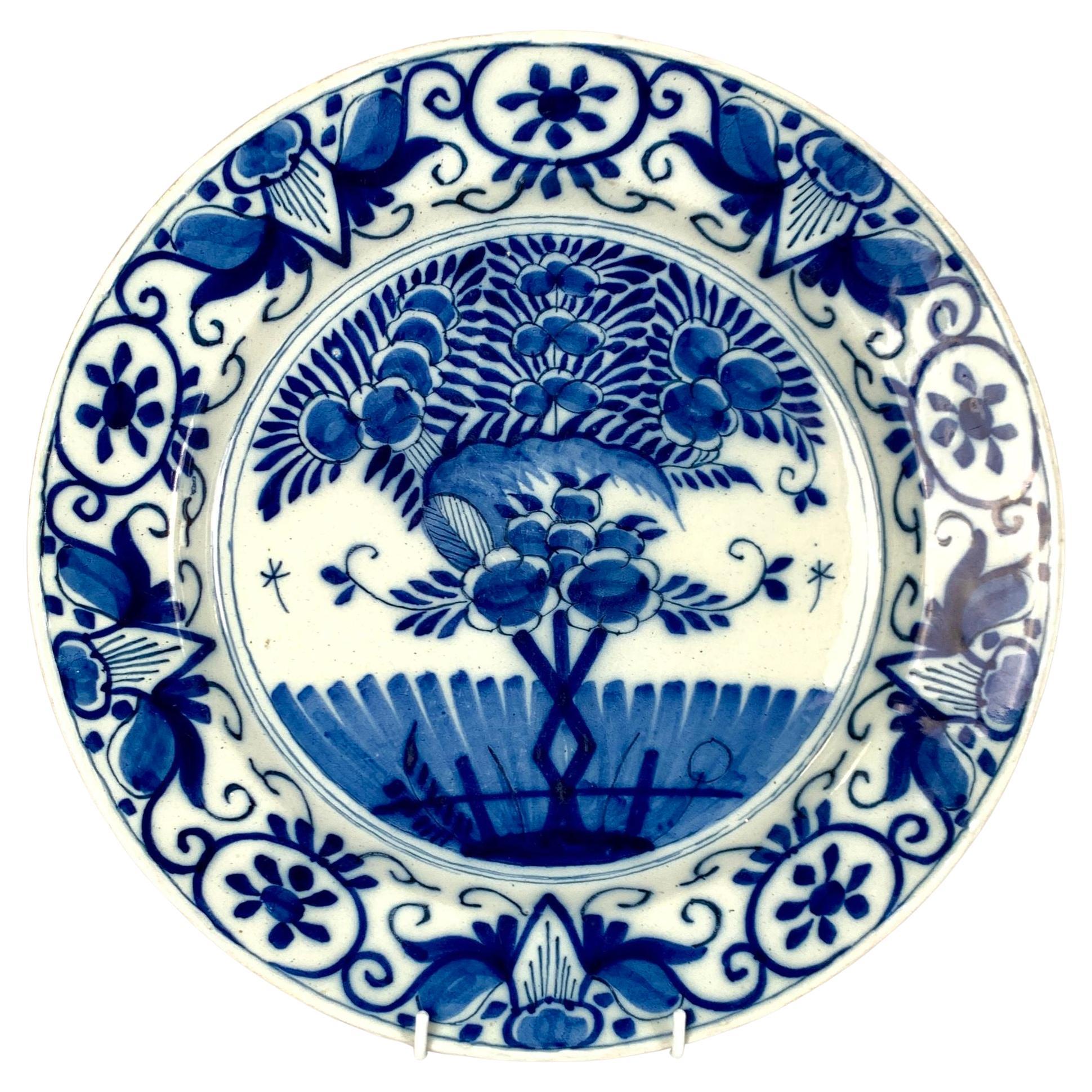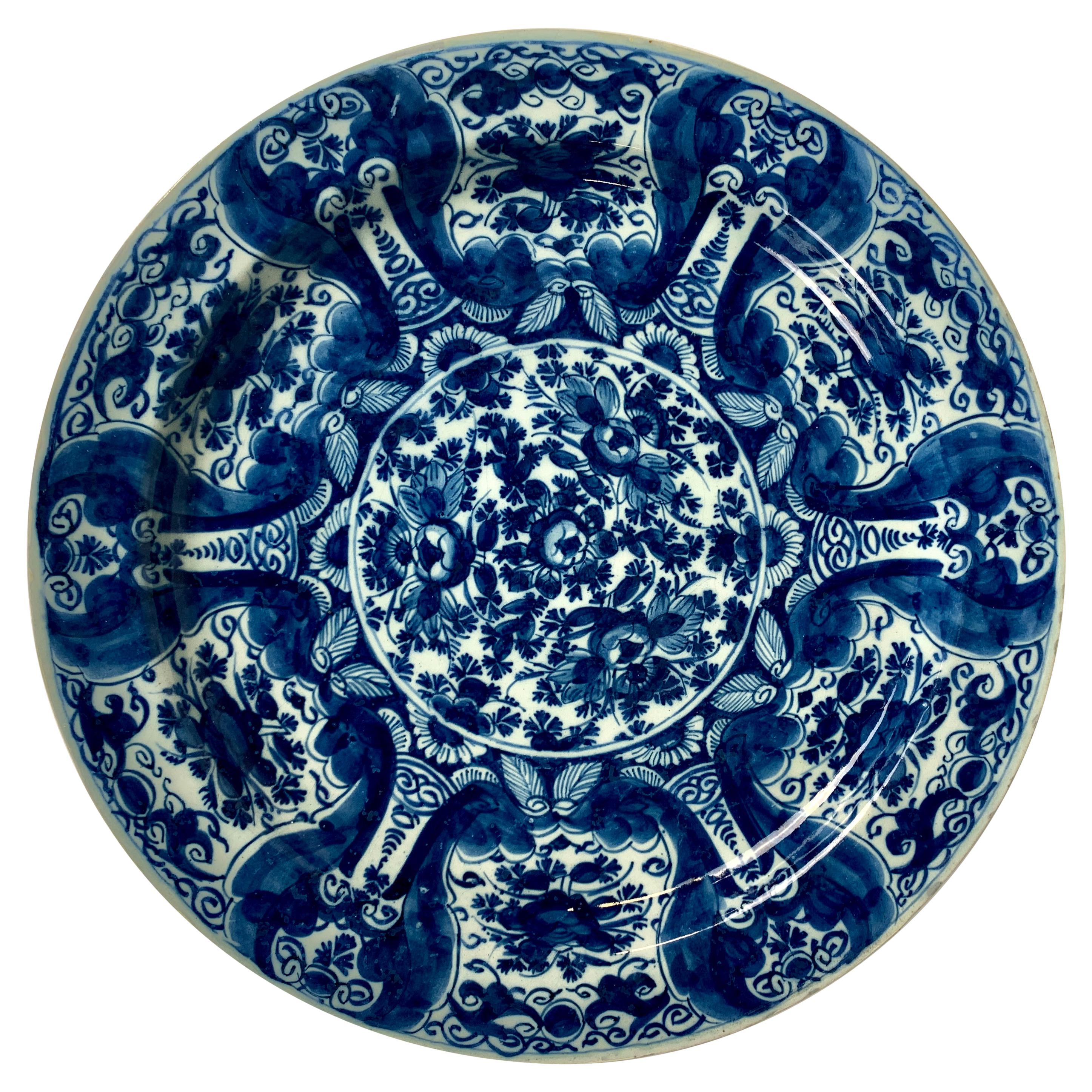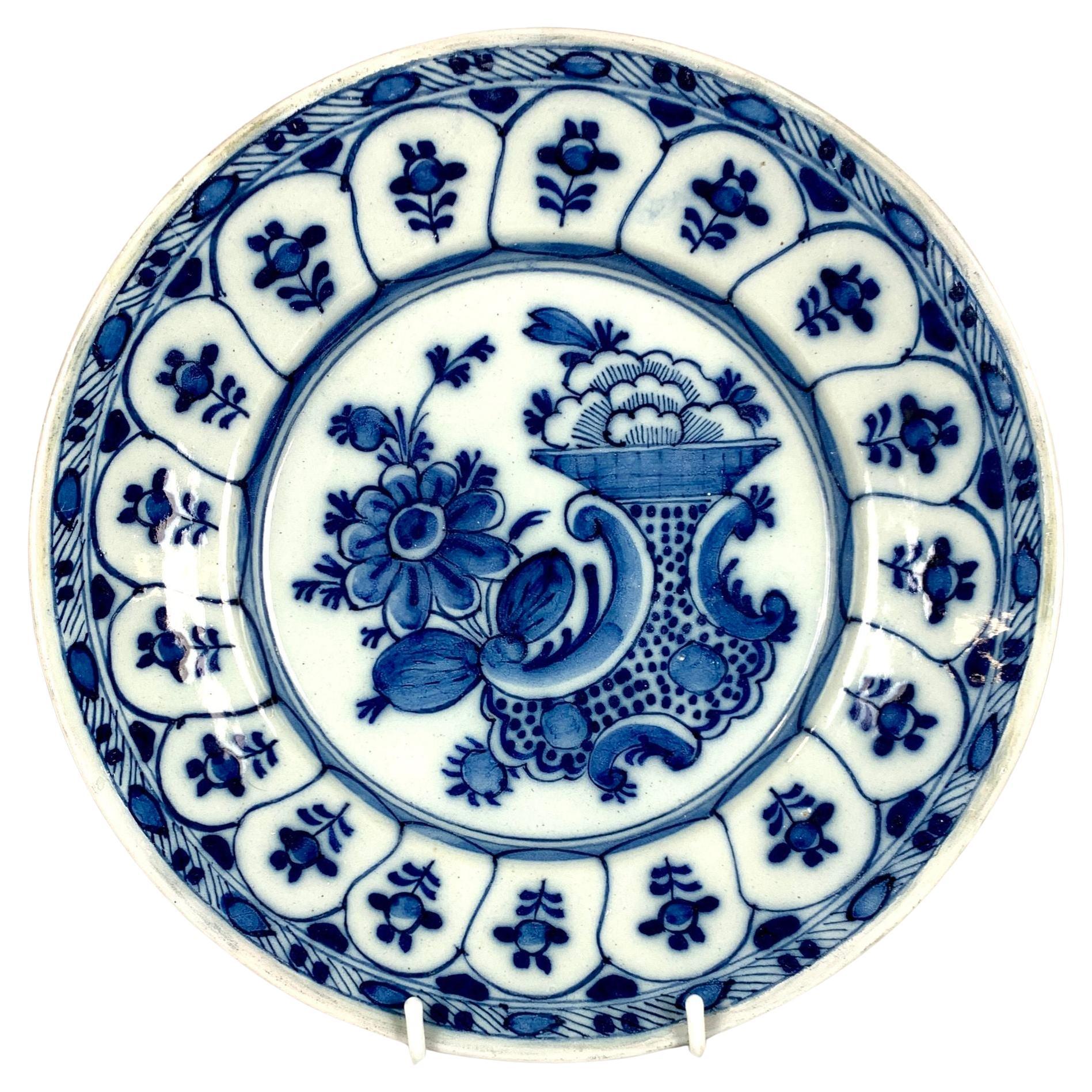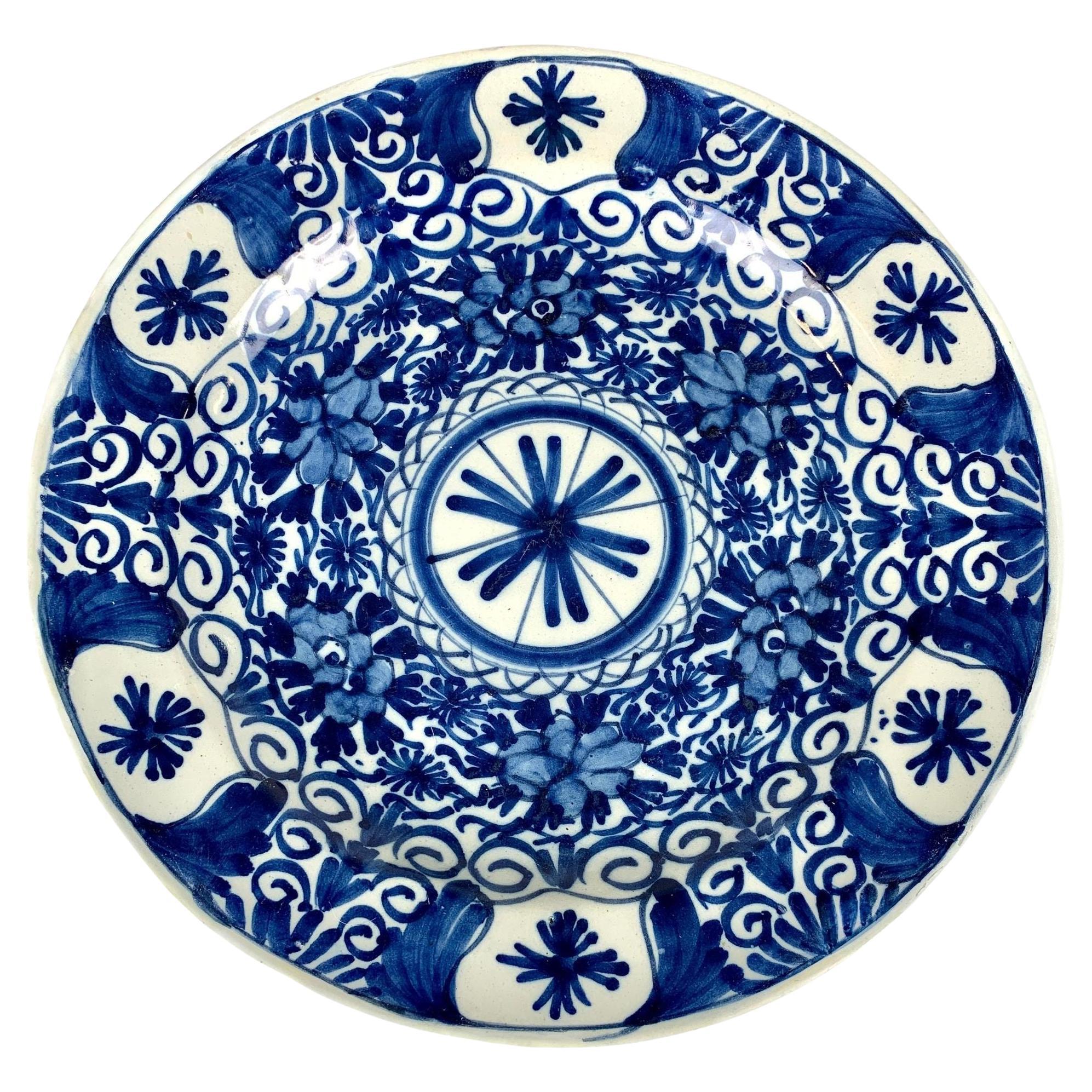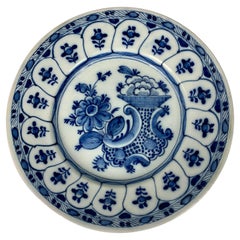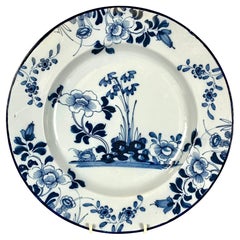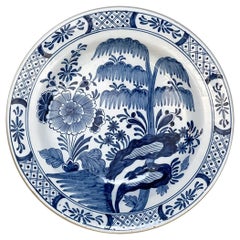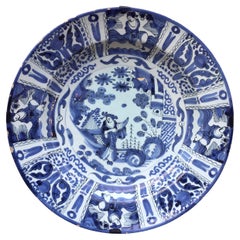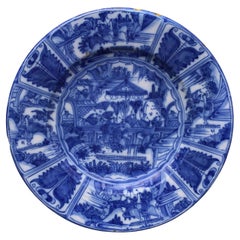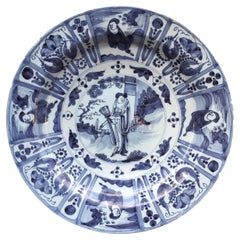Items Similar to Blue and White Delft Charger Hand Painted Netherlands 17th Century, Circa 1685
Want more images or videos?
Request additional images or videos from the seller
1 of 7
Blue and White Delft Charger Hand Painted Netherlands 17th Century, Circa 1685
$780
£578.79
€674.21
CA$1,085.77
A$1,209.10
CHF 629.27
MX$14,908.03
NOK 8,014.22
SEK 7,532.59
DKK 5,030.45
Shipping
Retrieving quote...The 1stDibs Promise:
Authenticity Guarantee,
Money-Back Guarantee,
24-Hour Cancellation
About the Item
This blue and white Delft charger was hand-painted with a chinoiserie scene in the late 17th century.
The decoration style was taken directly from Kraak porcelain chargers exported from China to Europe in the 17th century.
In the center, we see a vase sitting on the garden terrace, overflowing with beautiful flowers.
Among the flowers is a scroll, one of the Eight Treasures often depicted in Chinese decorative art of this period. Two butterflies hover around the flowers.
The wide border has panels showing sunflowers and traditional Chinese objects of good fortune.
Dimensions: 12.75" in diameter
Condition: Very good, with small chips invisibly restored
Price: $680.
- Dimensions:Height: 2 in (5.08 cm)Diameter: 12.75 in (32.39 cm)
- Style:Qing (Of the Period)
- Materials and Techniques:
- Place of Origin:
- Period:Late 17th Century
- Date of Manufacture:circa 1785
- Condition:Refinished. small chips invisibly restored.
- Seller Location:Katonah, NY
- Reference Number:1stDibs: LU866531589702
About the Seller
5.0
Recognized Seller
These prestigious sellers are industry leaders and represent the highest echelon for item quality and design.
Platinum Seller
Premium sellers with a 4.7+ rating and 24-hour response times
Established in 1962
1stDibs seller since 2009
483 sales on 1stDibs
Typical response time: <1 hour
- ShippingRetrieving quote...Shipping from: Katonah, NY
- Return Policy
Authenticity Guarantee
In the unlikely event there’s an issue with an item’s authenticity, contact us within 1 year for a full refund. DetailsMoney-Back Guarantee
If your item is not as described, is damaged in transit, or does not arrive, contact us within 7 days for a full refund. Details24-Hour Cancellation
You have a 24-hour grace period in which to reconsider your purchase, with no questions asked.Vetted Professional Sellers
Our world-class sellers must adhere to strict standards for service and quality, maintaining the integrity of our listings.Price-Match Guarantee
If you find that a seller listed the same item for a lower price elsewhere, we’ll match it.Trusted Global Delivery
Our best-in-class carrier network provides specialized shipping options worldwide, including custom delivery.More From This Seller
View AllDutch Delft Blue and White Charger Hand Painted 18th Century Circa 1780
Located in Katonah, NY
This lovely blue and white Delft charger was made in the Netherlands around 1780.
It was meticulously hand-painted in two shades of cobalt blue on a white tin-glazed surface.
The cen...
Category
Antique Late 18th Century Dutch Rococo Decorative Dishes and Vide-Poche
Materials
Delft
Blue and White Delft Dish Hand-Painted Netherlands, Circa 1780
Located in Katonah, NY
This blue and white hand-painted Dutch Delft dish was made in the Netherlands in the 18th century, circa 1780.
The composition has excellent movement. The ...
Category
Antique Late 18th Century Dutch Rococo Delft and Faience
Materials
Delft
Blue and White Delft Charger Hand Painted Liverpool England 18th Century Ca.1760
Located in Katonah, NY
This blue and white Delft charger was hand-painted in Liverpool, England, during the mid-18th century, around 1760. The design features simple yet elegant decoration, showcasing flow...
Category
Antique Mid-18th Century English Chinoiserie Delft and Faience
Materials
Delft
Blue and White Delft Charger Hand-Painted, Netherlands, 18th Century, Circa 1760
Located in Katonah, NY
The entire surface of this blue and white Dutch Delft charger is covered in deep beautiful cobalt blue coloring.
The center of the charger is filled with lovely hand-painted peonies...
Category
Antique Mid-18th Century Dutch Rococo Delft and Faience
Materials
Delft
Blue and White Dutch Delft Plate or Dish Netherlands Circa 1780
Located in Katonah, NY
This 18th century blue and white Delft plate was hand painted circa 1780.
The lively scene in the center features flowers, flower buds, and a polka-dotted vase.
The border is decorat...
Category
Antique Late 18th Century Dutch Decorative Dishes and Vide-Poche
Materials
Delft
Blue and White Delft Charger Hand Painted 18th Century Netherlands, circa 1780
Located in Katonah, NY
This beautiful blue and white hand painted charger was made in The Netherlands in the last quarter of the 18th century, circa 1780.
It is decorated with an eye-catching floral design...
Category
Antique Late 18th Century Dutch Rococo Delft and Faience
Materials
Delft
You May Also Like
17th Century Delft Blue & White Charger
Located in Dallas, TX
17th century delft blue & white charger is a timeless interpretation of the Japanese porcelains that were so popular in Europe, replicated by the master ceramicists in the Delft region of Holland, and most experts agree, equivalent in quality to the Oriental artworks...
Category
Antique Mid-17th Century Dutch Chinoiserie Delft and Faience
Materials
Ceramic
Large Dutch Delft Charger with Chinoiserie Decor in Wanli Style, 17th Century
Located in AMSTERDAM, NH
City: Delft
Workshop: Unknown
Date: Last quarter of the 17th century
A large blue and white plate in Wanli / Tianqi style
Decorated with a...
Category
Antique Late 17th Century Dutch Delft and Faience
Materials
Ceramic, Faience
Large Dutch Delft Charger with Chinoiserie Design, 17th Century
Located in AMSTERDAM, NH
City: Delft
Workshop: Unknown
Date: circa 1670 - 1680
A wonderful bright delft plate or charger with decoration in the Chinese Wanli style.
Massive piec...
Category
Antique Late 17th Century Dutch Delft and Faience
Materials
Ceramic, Faience
Large Dutch Delft Charger with Chinoiserie Decor in Wanli Style, 17th Century
Located in AMSTERDAM, NH
City: Delft
Workshop: Unknown
Date: Last quarter of the 17th century
A large blue and white plate in Wanli / Tianqi style
Decorated with Long Eliza in...
Category
Antique Late 17th Century Dutch Delft and Faience
Materials
Ceramic, Faience
18th Century Dutch Delft Plate with Chinoiseries Decoration
Located in Kastrup, DK
Antique 18th century Dutch Delft plate. Dia: 36 cm.
Blue and white chinoiserie decoration depicting a oriental garden landscape scene. The flange is decorated with flowers and fol...
Category
Antique 18th Century Dutch Baroque Delft and Faience
Materials
Delft
17th Century Delft Plate Chinoiserie Wanli Style Blue and White Delftware Charge
By AK Dutch Delftware, Delft, Royal Delft
Located in Wommelgem, VAN
Large 17th Century Delft dish Chinoiserie blue and white Delftware Charger
Material: Delft, earthenware, pottery.
Design: Ming Dynasty, Wanli style, Chinoiserie
Style: Ming, William ...
Category
Antique 17th Century Dutch Baroque Delft and Faience
Materials
Earthenware, Delft
More Ways To Browse
17th Century Blue And White
White Delft
Blue White Charger
Blue And White Chargers
Delft Chargers
Antique Delft Charger
Hand Paint China Dishes
Blue And White Chinoiserie Vase
Delft China
Antique Delft China
Flower And Butterfly Porcelain Vase
Delft Blue China
Delft Blue And White Chargers
Chinese Blue And White Charger
Chinese Blue And White Porcelain Charger
Export Charger
Kraak Charger
16 Dining Chairs
